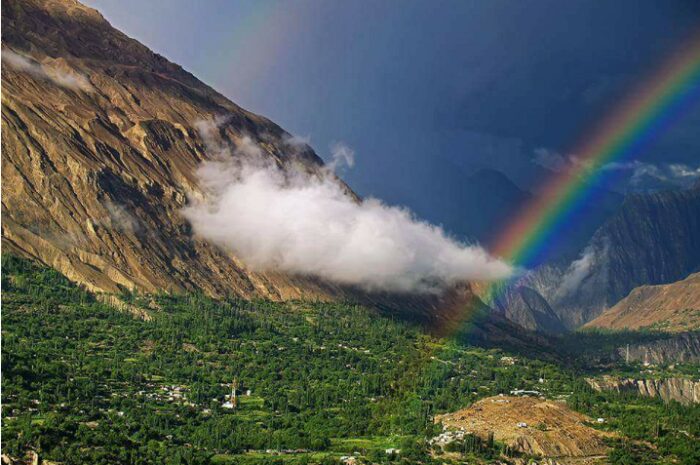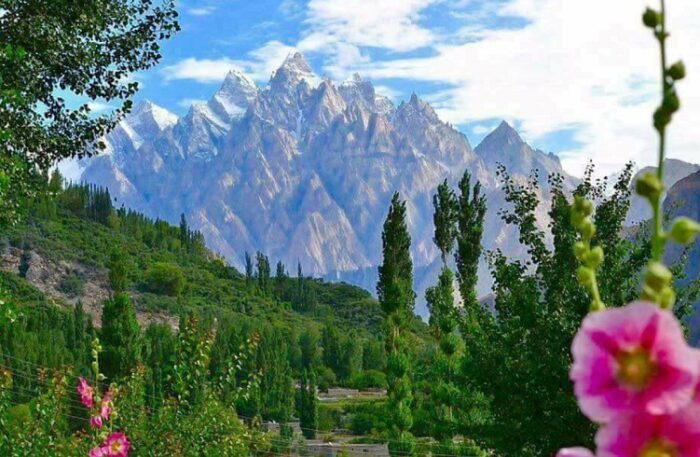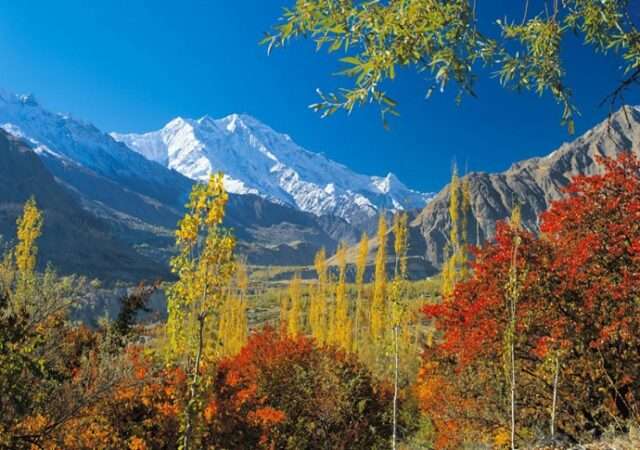Hunza Valley: A Scenic Beauty of Pakistan is a place that is worthful to visit at least once in a life time.
Pakistan has been gifted with aesthetic and natural beauty by Allah Almighty. It has many locations that are dangerously shrouded with lovely scenery.
Such glitzy and beautiful scenes inspire one to reflect on the magnificence and ingenuity of Allah. One of Pakistan’s most picturesque regions is Hunza. Hunza is a stunning alpine valley that was formerly referred to as “Heaven on Earth.”
The Hunza Valley is a mountainous valley formed by the Hunza River in the northern part of Pakistan’s Gilgit-Baltistan region.
Read Also
Erine Holland’s blissful Lahore Ride
It is bordered to the northwest by Ishkoman, to the southeast by Shigar, to the north by Afghanistan’s Wakhan Corridor, and to the northeast by the Chinese region of Xinjiang.
The Hunza Valley floor is 2,438 metres above sea level (7,999 feet). Geographically speaking, the Hunza Valley is divided into the Upper Hunza (known as Gojal), Central Hunza, and Lower Hunza (as Shinaki).
History
The predominant religions in the region were Buddhism and, to a lesser extent, Bön. Numerous Buddhist archaeological sites still exist in the area, including the Sacred Rock of Hunza.
There used to be Buddhist shelters close by. The Hunza Valley played a crucial role as a trade route connecting Central Asia and the subcontinent.

Additionally, it offered safety to Buddhist missionaries and monks travelling to the subcontinent, and the area was crucial in spreading Buddhism throughout Asia.
Before Islam arrived in this area in the 15th century, the majority religion in the area was Buddhism. Since then, the majority of the populace has embraced Islam.
Because the last Buddhists in this area relocated east to Leh, where Buddhism is the dominant religion, the presence of Buddhism in this area is now restricted to archaeological sites. Buddhist monks in the area created a large number of graffiti pieces in the ancient Brahmi alphabet on rocks as a form of worship and culture.
They had largely been ignored, destroyed, or forgotten after the majority of the population converted to Islam, but they are now being revived.
Hunza was once a princely state that bordered china state Xinjiang to the northeast and Pamir to the northwest. It persisted until Zulfikar Ali Bhutto ultimately disbanded it in 1974.
Read Also
The state shared borders with the former princely state of Nagar to the east and the Gilgit Agency to the south. Baltit, formerly known as Karimabad, served as the state capital.
Ganish Village, which translates to “Baba Ganesh village,” is another historic neighbourhood (a Buddhist name). After more than 900 years as a sovereign principality, Hunza became crucial to the British “Great Game” in the early 1800s.
After the British Empire conquered Hunza in 1891, the region’s ruler, Mir Safdar Ali Khan, fled to Kashgar, China, and the British army installed his brother, Mir Nazim Khan (1892–1938), as a puppet ruler of the Hunza Valley. However, all decisions were made by British officers stationed in Gilgit, the region’s capital.
Places to Visit
One of Pakistan’s most unique locations is Hunza. Around the Hunza Valley, there are a number of mountains with heights greater than 7,000 metres. Views from the valley include a number of mountains, including: Spantik, Rakaposhi, Ultar Sar, Bojahagur Duanasir, Diran peak, Ghenta peak, Hunza peak, Darmyani peak, and Ladyfinger peak.

Located above Karimabad, Baltit Fort is a Hunza landmark that dates back roughly 800 years. Its wooden bay windows stare out over the valley as it stands on large legs. It was once utilised as the Hunza’s former rulers, known as the Mirs, dwelling.
The Karakoram Mountains’ Khunjerab Pass is a mountain pass that rises 4,693 metres. It is situated in Hunza and in a key location on the southwest border of China and the northern border of Pakistan.
Read Also
Cricket World Cup 2023 is set to be in India
Views can also be found on eco-friendly hiking trails like Ondra Poygah Gulmit and Leopard Trek Shiskhat. The Hunza Valley boasts a variety of stunning natural attractions that draw travellers. Every year, thousands of tourists come to the Hunza valley and its surroundings to take in the natural beauty.
Visitors come to this valley to see the two most well-known forts, Altit and Baltit fort. The Altit Fort, which situated in the Altit settlement, is the oldest fort in the northern regions.
A great architectural design was used to construct it on a mountain’s rock, with the Hunza River flowing behind it. Another stunning fort in the Hunza valley is called Baltit Fort, and it is situated at the summit of Karimabad. Following repair, the Baltit fort is now a heritage museum.
The Karimabad Bazaar in Hunza is highly known for its regional handicrafts, including handmade carpets, traditional and embroidered headgear, various shawls, handwoven fabric, and gemstones like rubies. The Ruby mines are well-known destinations for tourists.

The snow-capped and rugged mountains of the Hunza valley are well-known. Many tourists travelled to Hunza specifically to catch a glimpse of the Rakaposhi Mountain’s brilliant ice wall. Passu Peak, Ultra Peak, and Kuksel Sar are three further well-known mountains in Hunza.
Another motivation for travellers to come to the Hunza valley is the Khunjerab Pass and Khunjerab National Park. Pakistan’s border with China lies at the Khunjerab Pass. The Karakoram Mountains’ Khunjerab Pass is located above sea level and features a high mountain pass.
Hunza’s Gojal Valley is well known for its lakes. Gojal Valley contains Attabad Lake. This lake was created as a result of the significant terrain slide that occurred in 2010 and stopped the Hunza River from flowing. Today, it is a well-known picnic area and tourist landmark. Boating enthusiasts will adore the Attabad Lake.
Read Also
Mind Blowing Health Benefits of Gur (Jaggery)
Tourists can enjoy magnificent views of the Hunza River and the winding Karakoram Highway from Duikar. Duikar, which is located above sea level, has become a well-known landmark.
Although it also offers breathtaking views of the Rakaposhi and the Golden Peak, many visitors come to Duikar only to take in the breathtaking sunrise and sunset scenes.
In addition to all of this, the Hunza Valley is home to Pakistan’s most well-known and extensive glaciers. The Hussaini, Passu, and Batura glaciers are a few of Hunza’s well-known glaciers. Fairy Meadows near Hunza is also beautiful place to visit.
These glaciers are all located in the Gojal Valley. Every year, these glaciers draw tens of thousands of tourists from both domestic and foreign countries. In the Hunza Valley, hiking opportunities are incredibly plentiful.
Top 5 Hotels in Hunza
There are a lot of 4-star and 5-star hotels in Hunza Valley. However, following 5 are recommended:
- Luxus Hunza
- High Rock Hunza Hotels and Resorts
- Serena Altit Fort Residence
- Hard Rock Hunza Resort and Villas
- Eagle’s Nest Hotel
If you don’t like crowds, June to August are the worst months to visit the Hunza Valley. The best months are April to October. The Hunza Valley may get fairly congested in the middle of the summer as both locals and Chinese visitors swarm to the region when the weather is warm and pleasant.











